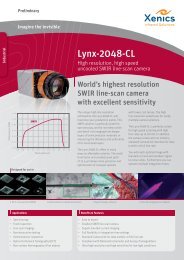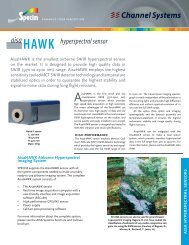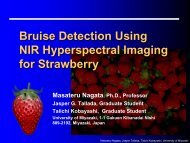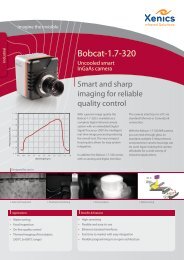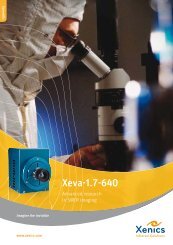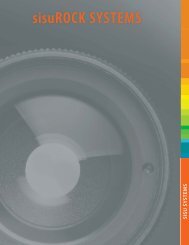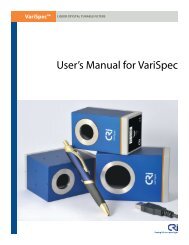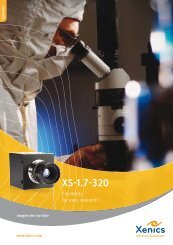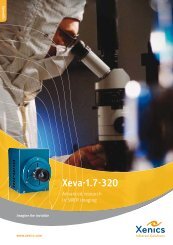Spectral flattening filters (pdf) - Spectral Cameras
Spectral flattening filters (pdf) - Spectral Cameras
Spectral flattening filters (pdf) - Spectral Cameras
You also want an ePaper? Increase the reach of your titles
YUMPU automatically turns print PDFs into web optimized ePapers that Google loves.
<strong>Spectral</strong> Imaging Ltd.<br />
Teknologiantie 18A<br />
Fin-90750 Oulu, Finland<br />
Tel +358 8 5514495 Fax +358 8 5514496<br />
www.specim.fi<br />
Technical note TN-0017<br />
Problem<br />
<strong>Spectral</strong> <strong>flattening</strong> filter at VNIR (400-1000nm) and<br />
SWIR (1000-2500nm) range. Date 8 February 2007<br />
Author(s) HKA Ver 1.0<br />
1. Introduction<br />
When using spectral cameras and spectrographs the usual behaviour of system is that it is<br />
working better at certain part of the wavelength range and the SNR tend to decrease at some<br />
other regions of the wavelength range. Due to the light source radiance, detector response and<br />
systems instrument function it is sometimes worth of even necessary to use <strong>filters</strong> to balance the<br />
system in order to increase the SNR at some wavelength bands and improve the use of dynamic<br />
range of the detector.<br />
Usually the dominant element is the light source. The most often used light source is<br />
simulating blackbody radiator with different colour temperatures (T C ). The next figures illustrates<br />
the difference between Sun radiance (T C = 6500K) and normal halogen light radiance (T C =<br />
3000K) at VNIR an SWIR range.<br />
Figure 1 Often used light sources at VNIR and SWIR range.
<strong>Spectral</strong> Imaging Ltd.<br />
Teknologiantie 18A<br />
Fin-90750 Oulu, Finland<br />
Tel +358 8 5514495 Fax +358 8 5514496<br />
www.specim.fi<br />
Technical note TN-0017<br />
2. Problem solution<br />
(a) VNIR range<br />
The most used light source in VNIR range is Halogen light because most of the measurements<br />
are done in laboratory. In this case the problem is the blue end of the spectrum where the signal<br />
of the source gets low. For this purpose we recommend a blue or violet <strong>filters</strong> like,<br />
• Hoya LB-100 known as 80B<br />
• Hoya LB-120 known as 80A<br />
• Hebo Spezialglas SSB 130<br />
• Hoya M-30 (violet)<br />
The <strong>filters</strong> listed above are blue ones and they transmit the blue part of the spectrum and absorb<br />
the red end and short infrared. The violet Hoya M-30 balances the effect of spectrograph<br />
efficiency and detector response which are both highest at wavelengths 500-600nm. The<br />
transmittance of the <strong>filters</strong> is showed in the next figure.<br />
Figure 2 The recommended spectral <strong>flattening</strong> <strong>filters</strong> for VNIR range when using halogen light source.
<strong>Spectral</strong> Imaging Ltd.<br />
Teknologiantie 18A<br />
Fin-90750 Oulu, Finland<br />
Tel +358 8 5514495 Fax +358 8 5514496<br />
www.specim.fi<br />
Technical note TN-0017<br />
(b) SWIR range<br />
The most used light source in SWIR range is halogen light because most of the measurements are<br />
done in laboratory. In this case the problem is the long end of the spectrum where the signal of<br />
the source gets low. When using the Sun light the situation is exactly the same. For this purpose<br />
we recommend the same blue <strong>filters</strong> like in VNIR range. They are<br />
• Hoya LB-100 known as 80B<br />
• Hoya LB-120 known as 80A<br />
• Hebo Spezialglas SSB 130.<br />
With the <strong>filters</strong> listed above the transmittance increases when approaching the 2500nm. The<br />
transmittance of the filter is showed in the next figure.<br />
Figure 3 The recommended spectral <strong>flattening</strong> <strong>filters</strong> for SWIR range when using either halogen light or the Sun as<br />
light source.<br />
Specim provides the SWIR <strong>filters</strong> with special coating. The filter is coated to block the<br />
wavelengths 800-960nm. This special filter is working like blue filter listed above except this<br />
blocking range. The reason for this special coating is the fact that SWIR detectors are already<br />
sensitive from 800nm on and these wavelengths cannot be filtered by Order Blocking Filter<br />
(OBF).
<strong>Spectral</strong> Imaging Ltd.<br />
Teknologiantie 18A<br />
Fin-90750 Oulu, Finland<br />
Tel +358 8 5514495 Fax +358 8 5514496<br />
www.specim.fi<br />
Technical note TN-0017<br />
The difference between measured SWIR signal of the halogen source is showed in next figure.<br />
Figure 4 The filtered and unfiltered SWIR measurements<br />
From the previous figure one can see the purpose of the filter. When using the filter one can<br />
increase the integration time avoiding saturation in 1500nm and increase the signal in the<br />
wavelengths 2000-2500nm. Like this one can improve the SNR at long wavelengths.



